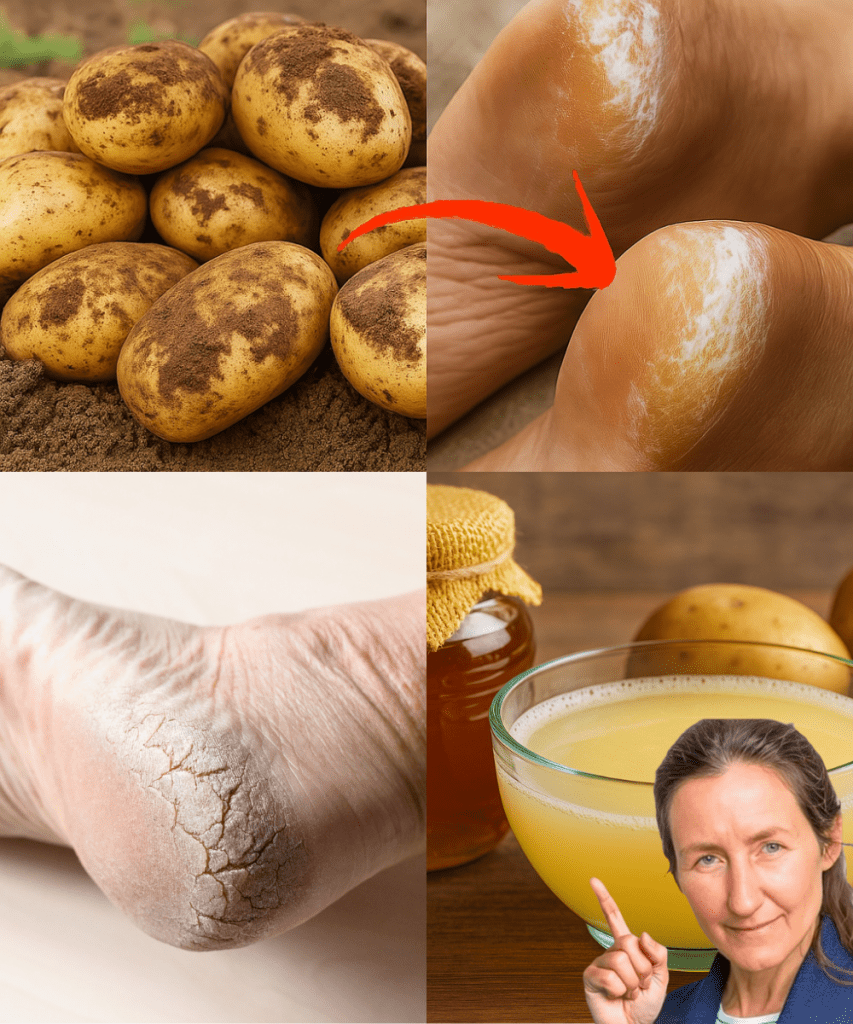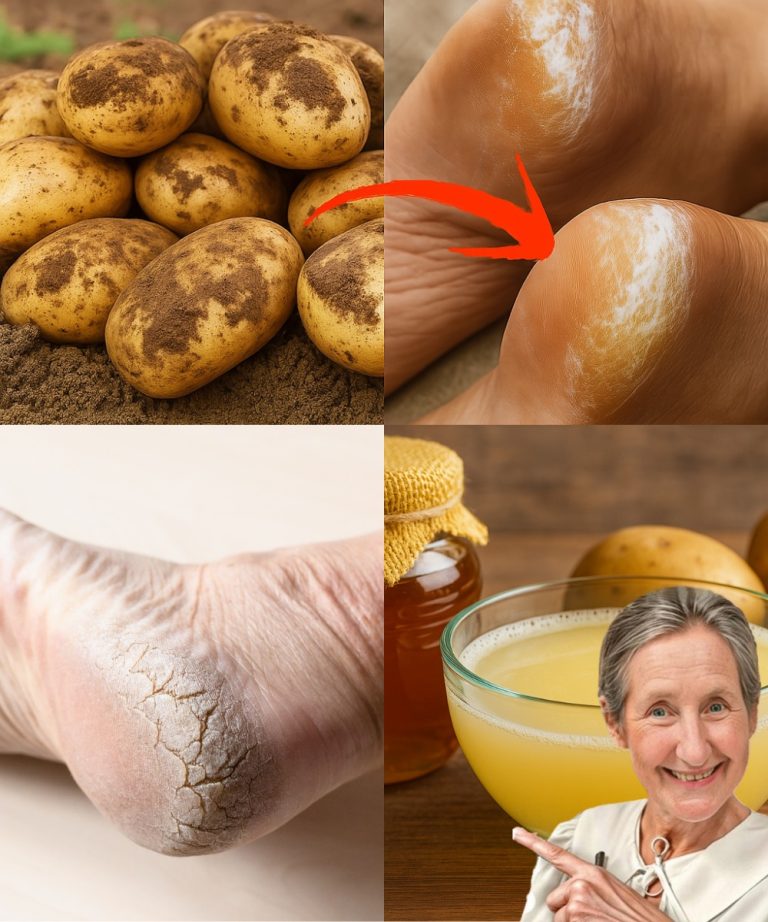Cracked heels, or heel fissures, occur when the skin on your heels becomes dry, thickened, and splits under pressure. Common culprits include dehydration, prolonged standing, ill-fitting shoes, or dry weather, according to the Mayo Clinic. Left untreated, these cracks can deepen, causing discomfort or even infection. While moisturizers and foot creams are go-to solutions, the potato trick offers a natural, budget-friendly way to hydrate and soften your heels, setting the stage for healthier feet.
The Surprising Power of Potatoes
Potatoes might be a dinner staple, but they’re also a skincare secret weapon. Packed with moisture, vitamin C, and enzymes like catecholase, potatoes can hydrate and gently exfoliate rough skin. The National Library of Medicine highlights that these enzymes may help break down dead skin cells, while vitamin C supports collagen production for stronger, healthier skin. Though scientific studies on potatoes for cracked heels are limited, their hydrating and soothing properties make them a beloved folk remedy. Best of all? They’re cheap, natural, and likely already in your kitchen!
Benefits of the Potato Trick
- Deep Hydration: Potatoes’ high water content moisturizes dry, cracked heels.
- Gentle Exfoliation: Natural enzymes soften rough patches for smoother skin.
- Nutrient Boost: Vitamin C promotes skin repair and elasticity.
- Cost-Effective: No need for expensive creams—just grab a potato!
How to Use the Potato Trick for Cracked Heels
Ready to give your heels some love? This potato-based remedy is easy to prepare and use. Follow these steps to maximize its benefits while keeping your feet safe and healthy.
Ingredients
- 1 medium-sized potato
- 1 teaspoon honey or olive oil (optional, for extra hydration)
- Warm water and mild soap
- Fragrance-free moisturizer (like petroleum jelly or a cream with urea)
Step-by-Step Instructions
- Prepare the Potato:
- Wash the potato thoroughly to remove dirt and bacteria.
- Peel and grate it into a fine pulp, or blend it into a smooth paste for easier application.
- Optional: Mix in a teaspoon of honey or olive oil to boost hydration and soothe the skin.
- Apply to Heels:
- Clean your feet with warm water and mild soap, then pat dry with a clean towel.
- Spread the potato mixture evenly over your cracked heels, focusing on rough or fissured areas.
- Cover with a clean cloth or plastic wrap to lock in moisture and prevent mess.
- Let It Work:
- Relax for 20–30 minutes to let the potato’s moisture and enzymes penetrate your skin.
- Avoid walking to keep the mixture in place.
- Rinse and Lock in Moisture:
- Rinse off the potato mixture with warm water and pat dry.
- Apply a thick layer of fragrance-free moisturizer, such as petroleum jelly or a cream recommended by the American Academy of Dermatology.
- Slip on clean cotton socks to seal in moisture and enhance absorption.
Frequency and Tips
- Use the potato trick 2–3 times per week for best results.
- Perform a patch test on a small area of skin to ensure no irritation occurs.
- For optimal results, apply at night and leave the moisturizer on while you sleep. ✅
Common Mistakes to Avoid
The potato trick is simple, but missteps can reduce its effectiveness or cause issues. Here’s what to steer clear of, based on advice from WebMD and dermatology experts:
- Using Unclean Potatoes: Dirty potatoes can introduce bacteria to cracked skin, risking infection. Always wash thoroughly.
- Skipping Moisturizer: The potato hydrates temporarily, but a quality cream is essential for long-term softness.
- Overusing the Remedy: Applying daily may irritate sensitive skin. Stick to a few times a week.
- Ignoring Severe Cracks: If your heels are bleeding or deeply cracked, consult a doctor before relying on home remedies.
Complementary Foot Care for Lasting Results
The potato trick shines when paired with a solid foot care routine. The Cleveland Clinic emphasizes that consistent care is key to preventing and healing cracked heels. Try these science-backed tips to enhance your results:
- Moisturize Daily: Use a cream with urea or lactic acid after bathing to soften skin and prevent new cracks.
- Choose Supportive Footwear: Opt for shoes with good arch support and cushioning to reduce pressure on your heels.
- Stay Hydrated: Drink 8–10 cups of water daily to keep your skin hydrated from within.
- Exfoliate Gently: Use a pumice stone 1–2 times per week to remove dead skin, but avoid aggressive scrubbing, which can worsen cracks.
- Limit Hot Showers: Hot water strips natural oils, so wash your feet with lukewarm water to preserve moisture.
When to Seek Professional Help
While the potato trick can work wonders for mild cracked heels, some cases need expert attention. The Mayo Clinic recommends seeing a doctor if you notice:
- Deep, bleeding cracks or signs of infection (redness, swelling, warmth).
- Persistent dryness despite regular moisturizing.
- Underlying conditions like diabetes or thyroid issues, which can exacerbate heel fissures.
A dermatologist or podiatrist may prescribe stronger creams or address health concerns affecting your feet.
Lifestyle Habits for Healthy, Happy Feet
Your daily habits play a big role in keeping cracked heels at bay. The CDC notes that overall wellness supports skin health. Incorporate these tips for smoother feet:
- Eat a Balanced Diet: Include foods rich in vitamin E, zinc, and omega-3s (like nuts, fish, and leafy greens) to support skin repair.
- Avoid Barefoot Walking: Walking barefoot on hard surfaces dries out heels. Wear slippers or cushioned shoes indoors.
- Change Socks Daily: Choose breathable cotton socks to keep feet dry and minimize irritation.
- Inspect Your Feet: Check regularly for early signs of dryness or cracks to address them promptly.

